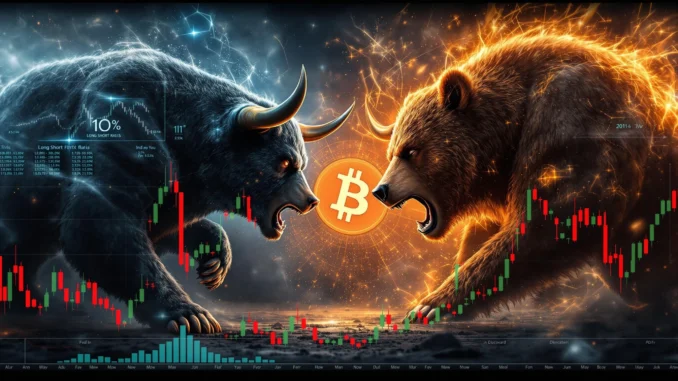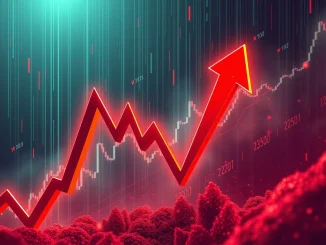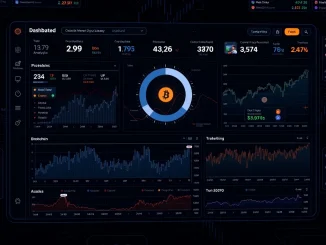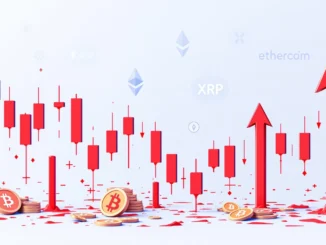
Ever wondered what the collective mood of the crypto market is, especially when it comes to Bitcoin? In the fast-paced world of cryptocurrency trading, understanding market sentiment is crucial, particularly for those navigating the volatile waters of Bitcoin futures. One powerful tool that offers a glimpse into this sentiment is the BTC long-short ratio. Let’s dive into the latest 24-hour snapshot of these ratios for BTC perpetual futures across leading cryptocurrency exchanges and decode what they might be telling us.
Decoding the Bitcoin Futures Market: What is the Long-Short Ratio?
Before we jump into the numbers, let’s break down what the BTC long-short ratio actually represents. In simple terms, it’s the proportion of traders who are betting on Bitcoin’s price going up (long positions) versus those who are betting on it going down (short positions) in the perpetual futures market. Think of it as a temperature gauge for market sentiment.
Here’s a quick breakdown:
- Long Positions: Traders who open long positions are essentially buying Bitcoin futures contracts, anticipating a price increase.
- Short Positions: Conversely, traders with short positions are selling Bitcoin futures contracts, expecting the price to decline.
- Long-Short Ratio: This ratio compares the total volume of long positions to short positions. A ratio above 50% for longs suggests more traders are bullish, while a ratio below 50% indicates a more bearish sentiment.
Understanding this ratio can be incredibly beneficial, offering insights into potential market movements and overall trader positioning. But remember, it’s just one piece of the puzzle in the complex world of crypto trading.
Why 24-Hour Bitcoin Long-Short Ratios Matter for Traders?
The 24-hour Bitcoin futures long-short ratio is particularly insightful because it captures the most recent shifts in market sentiment. Cryptocurrency markets are known for their volatility and rapid changes. A daily snapshot of these ratios helps traders:
- Gauge Short-Term Sentiment: Are traders becoming more bullish or bearish in the immediate term? A significant shift in the 24-hour ratio can signal a change in short-term market expectations.
- Identify Potential Overextension: Extreme ratios (either heavily long or heavily short) can sometimes indicate market overextension. For example, an overwhelmingly long ratio might suggest a potential pullback if the market becomes overheated.
- Compare Across Exchanges: Observing ratios across different exchanges like Binance, Gate.io, and Bybit can reveal nuances in sentiment specific to each platform’s user base.
- Inform Trading Strategies: While not a standalone indicator, long-short ratios can be a valuable input when formulating trading strategies, especially when combined with other technical and fundamental analysis tools.
However, it’s crucial to remember that these ratios are not crystal balls. They reflect trader positioning but don’t guarantee future price movements. Markets are influenced by a multitude of factors beyond just long-short ratios.
Analyzing the Current 24-Hour BTC Long-Short Ratio: A Detailed Look
Let’s delve into the latest 24-hour BTC long-short ratio data. As of the latest update:
Total (Across Exchanges):
- Long: 48.87%
- Short: 51.13%
Overall, the market sentiment appears slightly bearish, with short positions marginally outweighing long positions. However, the difference is quite narrow, suggesting a relatively balanced market or perhaps indecision among traders. Let’s break it down further by examining the top three exchanges:
Top Three Exchanges:
| Exchange | Long Positions | Short Positions |
|---|---|---|
| Binance | 48.76% | 51.24% |
| Gate.io | 48.66% | 51.34% |
| Bybit | 48.27% | 51.73% |
Across all three major exchanges – Binance, Gate.io, and Bybit – we observe a consistent trend: short positions slightly dominate long positions. Bybit shows the most pronounced bearish leaning among these three, while Binance and Gate.io are very closely aligned with the overall market average.
Leveraging Crypto Leverage Insights: How to Interpret and Use Long-Short Ratios in Trading?
So, how can traders use this crypto leverage sentiment data to inform their strategies? Here are a few actionable insights:
- Confirming Trends (or Spotting Potential Reversals): If you’re already seeing bearish signals from other indicators, a higher short ratio could strengthen your conviction. Conversely, if you spot a sudden surge in long positions while the price is consolidating, it might hint at a potential bullish breakout.
- Identifying Contrarian Opportunities: A very high long ratio could suggest that the market is becoming overly bullish and potentially due for a correction. Contrarian traders might see this as an opportunity to take short positions, betting against the prevailing sentiment. Similarly, an extremely high short ratio might present a long opportunity.
- Risk Management: Be cautious when the ratio is heavily skewed in one direction. High leverage combined with one-sided positioning can amplify volatility and increase the risk of sharp price swings and liquidations.
- Cross-Exchange Analysis: Notice discrepancies in ratios across exchanges. Significant differences might indicate localized sentiment or even potential arbitrage opportunities, although arbitrage in futures based on sentiment ratios is complex and risky.
Important Disclaimer: Long-short ratios should not be used in isolation. They are most effective when combined with other forms of analysis, including technical analysis (chart patterns, indicators), fundamental analysis (news, on-chain metrics), and your own risk management strategy. Trading based solely on long-short ratios is highly speculative and not recommended.
Factors Influencing Bitcoin Market Sentiment and Long-Short Ratios
Several factors can influence the Bitcoin market sentiment and consequently, the BTC long-short ratio. These include:
- Market News and Events: Major news announcements, regulatory updates, macroeconomic events, and significant developments in the crypto space can all trigger shifts in sentiment and trader positioning.
- Price Action: Recent price movements play a significant role. A sharp price drop might lead to an increase in short positions, while a strong rally could encourage more long positions.
- Funding Rates: In perpetual futures markets, funding rates incentivize traders to balance the market. Extremely positive funding rates (cost to hold longs) might discourage excessive long positions, and vice versa.
- Trader Psychology: Fear and greed are powerful drivers in crypto markets. Market psychology, often influenced by social media and online communities, can contribute to herd behavior and impact long-short ratios.
Conclusion: Staying Informed with Bitcoin Futures Data
The 24-hour BTC long-short ratio provides a valuable, albeit snapshot view, into the ever-evolving sentiment of the Bitcoin futures market. While currently indicating a slightly bearish leaning, the ratios are closely balanced, suggesting a market in a state of delicate equilibrium. For traders, monitoring these ratios across exchanges like Binance, Gate.io, and Bybit, and integrating this data with a broader analysis framework, can contribute to more informed and potentially profitable trading decisions. Remember to always trade responsibly and manage your risk effectively in the exciting but unpredictable world of cryptocurrency.



